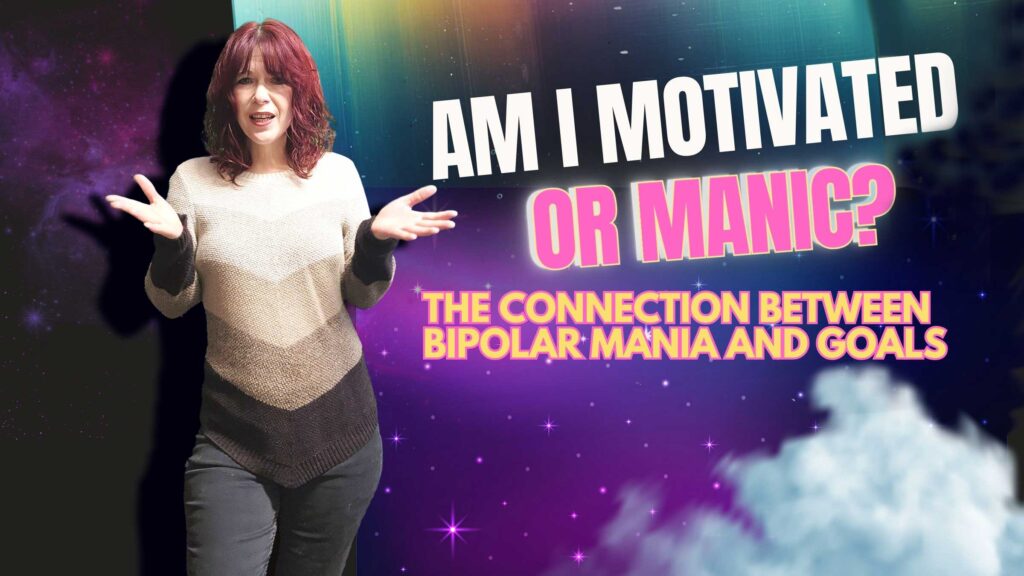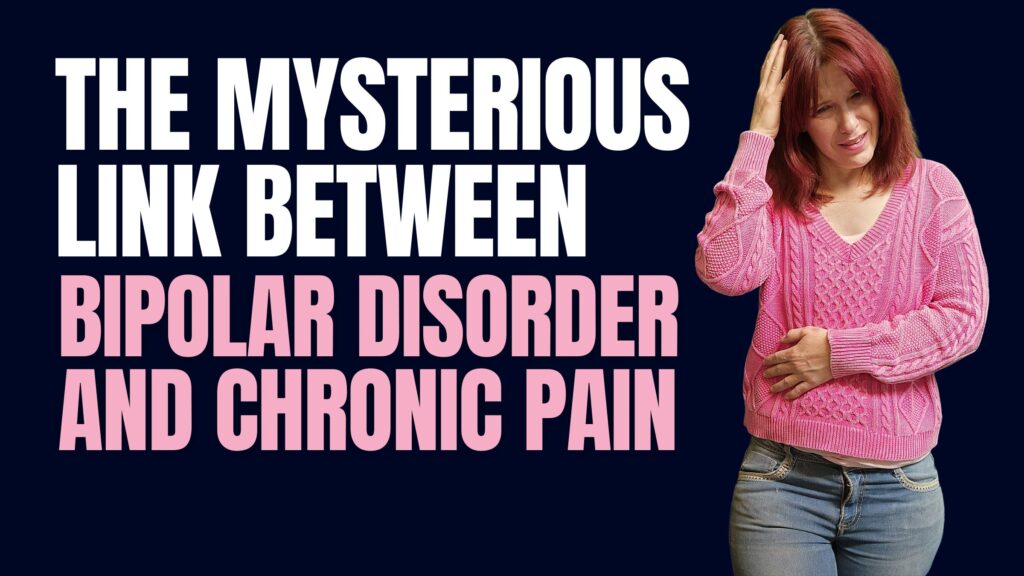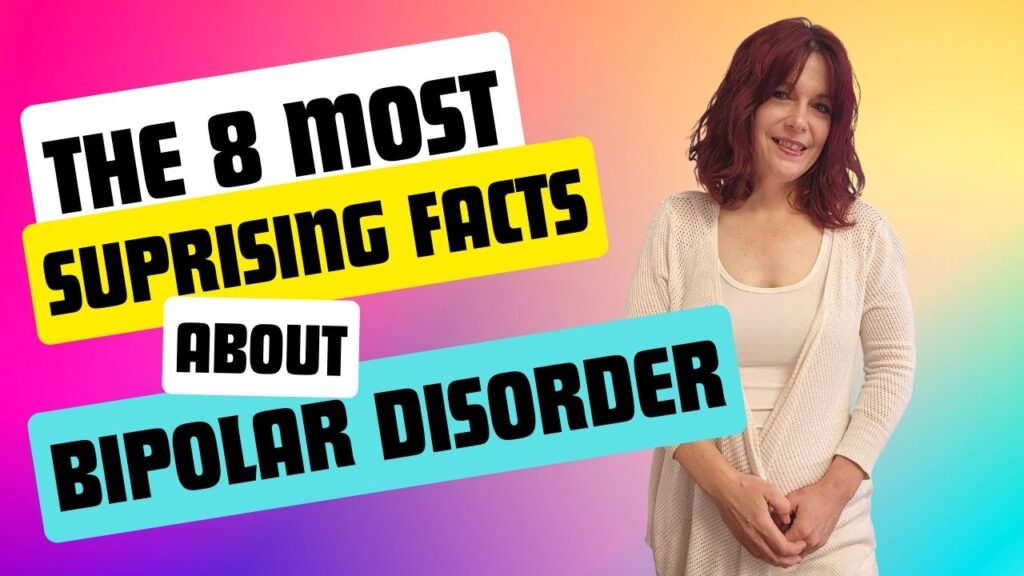Let’s learn more about some surprising and little-known Bipolar Disorder facts.
The majority of people have a basic understanding of what Bipolar Disorder is. They might know some of the symptoms of Bipolar Disorder, like the fact that it can cause a person to have mood swings, mania, or depression, but beyond that, most people don’t know much more. Even those of us who live with Bipolar Disorder may only know the Bipolar Disorder facts that are frequently talked about.
There are, however, many fascinating and interesting Bipolar Disorder facts that you probably don’t know about. This is what led me to research some of the lesser-known facts about Bipolar Disorder.
These 8 Little-Known Bipolar Disorder Facts May Shock You!
In this post, I am going to share some of the most surprising Bipolar Disorder facts with you. I promise these won’t be the typical facts you already know about.
Bipolar Disorder Fact #1: Bipolar Disorder is a Physical Illness with Physical Symptoms
Most people think Bipolar Disorder is simply a mood disorder or mental illness, but Bipolar Disorder affects more than just your brain. Your physical health and entire body are impacted. If you’ve ever noticed that you experience tremendous energy swings where you feel completely exhausted or even sick, or you have physical pain, nausea, or migraines that coincide with your mood swings, this is all part of the disorder and part of the disorder that doesn’t get talked about.
Quick Facts About the Physical Symptoms of Bipolar Disorder
- People with Bipolar Disorder are 3.5 times more likely to suffer from migraines.
- The likelihood of developing Type 2 diabetes is three times higher in those with Bipolar Disorder.
- If you have Bipolar Disorder your risk of dying from Coronary Heart Disease may be doubled.
- People with Bipolar Disorder are also twice as likely to experience premature death due to physical causes, unrelated to suicide.
- Approximately 25 percent of people who have fibromyalgia also have Bipolar Disorder.
- People who have Rheumatoid arthritis are twice as likely to be diagnosed with Bipolar Disorder.
In general, those of us with Bipolar Disorder have more issues with our physical health and not just our mental health. The disorder causes us to feel both emotional and physical pain. We are also more likely to die an early death, develop Type 2 Diabetes, or die from heart disease.
Interestingly, people who have Bipolar Disorder are 3 and a half times more likely to suffer from migraines than people without the disorder. And, more severe forms of Bipolar Disorder are associated with migraines.
Bipolar Disorder often co-occurs with other pain conditions including fibromyalgia and rheumatoid arthritis. People with Rheumatoid arthritis are twice as likely to have Bipolar Disorder. Similarly, 25 percent of people who have fibromyalgia also have bipolar disorder, and some research suggests that the overlap between the two conditions may be significantly higher.
Both fibromyalgia and Bipolar Disorder have been associated with elevated levels of inflammatory cytokines. Additionally, research suggests that inflammation has been observed in all phases of Bipolar Disorder. Abnormalities in the HPA axis, a part of the brain responsible for regulating stress responses, mood, metabolism, and the immune system, are common in both fibromyalgia and Bipolar Disorder. Moreover, both conditions are associated with mitochondrial dysfunction, which I will discuss further a little later in this post.
Chronic muscular-skeletal pain that is not fibromyalgia but rather a pseudofibromyalgia, may be associated with Bipolar Disorder. Unfortunately, there hasn’t been enough research on the relationship between Bipolar Disorder and chronic pain. We are aware that Bipolar Disorder affects more than our moods, though. It has an impact on our physical energy and, for some people, it may even cause physical pain.
Bipolar Disorder Fact #2: Preemies & Low Birth Weight Babies are More Likely to Develop Bipolar Disorder
Most people recognize the importance of prenatal care. We know that babies who are born early or at a low birth weight may face developmental delays and other challenges. However, a fact that’s not widely known is that low birth weight and prematurity are highly linked to psychiatric disorders in adulthood.
This little-known bipolar fact should be more talked about. A study in the Journal of Pediatrics found that babies born with a low birth weight are 2.5 times more likely to experience psychiatric disorders when they grow up. And if a baby is born with a very low birth weight (less than 1500g or 3.3 lbs), their risk goes up even more. These very low birth weight babies are 4.5 times more likely to develop psychiatric issues in adulthood.
Babies born prematurely have a greater likelihood of developing Bipolar Disorder as well. Research from King’s College London and the Karolinska Institute in Stockholm found that babies born between 32 and 36 weeks were 2.7 times more likely to develop Bipolar Disorder, while those born before 32 weeks faced an even higher risk, and were 7.4 times more likely.
Bipolar Disorder Fact #3: Nightmares May Predict a Manic Episode
During my early adulthood, I suddenly developed a severe fear of the dark, a condition known as nyctophobia, which I hadn’t experienced before. This fear mainly stemmed from the fact that I kept having terrible nightmares. What many people may not realize is that people with Bipolar Disorder often have nightmares, and these nightmares can sometimes be a warning sign of an impending manic episode.
People with psychiatric disorders tend to experience more nightmares than the general population. While there’s been more research on the connection between schizophrenia and nightmares, those of us with Bipolar Disorder also have nightmares more frequently. And, some individuals with Bipolar Disorder may experience a shift in their mood following a nightmare, often transitioning from a normal mood to a manic one, especially after dreams involving death or bodily harm.
Bipolar Disorder Fact #4: People Who Have Bipolar Disorder Are More Sensitive to Sunlight
You might be surprised by how much light and sunshine affect people with Bipolar Disorder. No, we are not vampires, but there does seem to be a strong correlation between light and our moods. This might be because sunlight regulates our circadian rhythm, and we are known to have problems with sleep and our circadian rhythms.
Still, sunlight affects us much more than the average person. Many of us with Bipolar Disorder struggle with seasonal mood changes that are directly related to the amount of sunshine we are exposed to. In fact, while less than 3 percent of the general population are diagnosed with SAD (Seasonal Affective Disorder), 25 percent of those with SAD also have Bipolar Disorder.
There are some other fascinating facts about the impact of sunlight on Bipolar Disorder. Changes in sunlight can influence both manic and depressive episodes. We see this in the rise of hospitalizations for mania during the spring and summer months and an increase in hospitalizations for depression during the winter months.
Furthermore, there’s some research indicating that children who get more daylight exposure in their early years may experience a delayed onset of Bipolar Disorder or an improvement in their circadian rhythm. It’s important to note that there isn’t enough evidence to definitively claim that sunlight in early childhood directly improves mental health outcomes. However, there is significant data supporting the fact that people with Bipolar Disorder are indeed influenced by sunlight.
Bipolar Disorder Fact #5: Bipolar Disorder is More Common in Women
Women are often stereotyped as being moodier than men. Still, it may surprise you to learn that women are diagnosed with Bipolar Disorder more often than men, and they often experience more severe symptoms than men. That’s because Bipolar Disorder symptoms can manifest differently in men and women.
Men typically exhibit symptoms at an earlier age. In spite of this, men might not be diagnosed right away because their manic symptoms can be mistaken for overconfidence or male ego. Likewise, when men get depressed, they tend to express it through anger or rage. This can make diagnosing men with Bipolar Disorder challenging. Plus, due to societal expectations and pressure, men may be less likely to seek out treatment.
Women typically present with symptoms of Bipolar differently. They might experience episodes of depression before showing any signs of mania. This can result in women being misdiagnosed or diagnosed later than men.
However, numerous studies confirm that Bipolar Disorder predominately affects women and often with greater severity. In a review of ten studies published over the last decade, all consistently indicated a higher prevalence of Bipolar Disorder among women compared to men. Unlike men, women are more inclined to be diagnosed with Bipolar II and rapid cycling Bipolar Disorder.
Due to the hormonal fluctuations that women experience, Bipolar Disorder may affect them more severely. This may explain why women struggle more with rapid cycling. Bipolar symptoms are often worse during the premenstrual phase of a woman’s menstrual cycle and during perimenopause, menopause, and pregnancy. Postpartum psychosis and depression are also common in women with bipolar disorder.
Bipolar Disorder Fact #6: Bipolar Disorder May Be a Metabolic Disorder of the Brain
The majority of people believe that Bipolar Disorder is caused by a “chemical imbalance” in the brain. However, a growing number of psychiatrists and mental health experts are starting to challenge this notion, claiming that there is no evidence to support this theory. There is mounting evidence that suggests bipolar disorder is not caused by a chemical imbalance after all, and may instead be caused by a metabolic disorder of the brain.
Dr. Christopher Palmer’s book Brain Energy (which I encourage everyone with Bipolar Disorder to read) discusses the research and evidence supporting his “brain energy” theory. He believes that mental illnesses are not due to chemical imbalances but are actually a result of a metabolic disorder of the brain. This theory might explain why conditions like diabetes, insulin resistance, and obesity are more prevalent among people with Bipolar Disorder.
People who have Bipolar Disorder (or other psychiatric conditions) may not produce enough ATP (a cellular form of energy) due to problems with how their mitochondria function. When our mitochondria aren’t working like they should, it can result in a metabolic disorder in the brain. Though the subject of mitochondria is complex, Dr. Palmer does an excellent job simplifying their role using relatable analogies.
He is one of the first doctors to promote the use of the ketogenic diet as a potential treatment for Bipolar Disorder. I’ve personally followed the ketogenic diet for over 5 years and can attest to the fact that the keto diet has been the most effective treatment I have used for Bipolar Disorder.
It requires commitment, education, and effort, but it offers a more effective alternative with fewer side effects compared to traditional medications. However, before you decide to just hop off your meds, please be sure to consult your doctor. This is not an approach you want to try without supervision and you should never abruptly stop taking prescribed medications.
Dr. Palmer isn’t the only one exploring metabolic issues in the brain as a potential cause of mental illnesses. Some in the medical community refer to this as the “selfish brain” theory. Essentially, this theory suggests that the brain, which uses around 25 percent of the body’s total calories for energy, prioritizes its own function. If the brain isn’t efficiently metabolizing energy, it may divert metabolic resources from the rest of the body, so that your brain functions properly. This can result in inefficient glucose metabolism in the body (i.e. insulin resistance), and cause disruptions in overall energy metabolism.
Bipolar Disorder Fact #7: Religious & Spiritual Experiences Can Be Confused with Bipolar Disorder
Although many mental health professionals typically approach mental health concerns from a medical standpoint, it’s important to recognize that there’s a fine line between the intense emotional states experienced in Bipolar Disorder and the profound emotions associated with spiritual awakening or spiritual encounters. Take, for example, the Pentecostal movements, where people participate in emotional and spiritual activities like dancing, crying, or speaking in tongues. Likewise, individuals who experience mystical or divine revelations during spiritual enlightenment illustrate the complex interconnection between emotions and spirituality.
In the United States, mental illness is often viewed as a medical condition. Yet, it’s worth noting that many Americans wouldn’t brand historical figures like Paul from the New Testament as being delusional or mentally ill, even though he claimed to have heard the voice of God. Similarly, followers of Buddhism, Hinduism, or Islam generally wouldn’t classify their revered prophets as psychotic or Bipolar.
In today’s culture, we may view mystical, visionary, or spiritual experiences that resemble Bipolar mania as being a symptom of the disorder. However, psychosis and spiritual awakening can sometimes resemble one another.
Since religion and spirituality can sometimes challenge the conventional medical approach to mental health, the DSM-5 has introduced a diagnostic code for “Religious or Spiritual Problems.” These experiences might include mystical experiences, near-death experiences, or engagement in meditation and spiritual practices that may induce altered emotional states.
Bipolar Disorder Fact #8: Medications Don’t Work for 50 Percent of Bipolar Patients
This is perhaps the most surprising Bipolar Disorder fact of all, and unfortunately, most people do not realize this. Most people think that if you just take your pills like you’re supposed to your Bipolar Disorder magically goes away. Unfortunately around half of all Bipolar patients are considered “treatment resistant” even after trying multiple medications or combinations of medication. What’s more, a staggering 90 percent of Bipolar patients will experience a relapse at some point in their lives.
This is one of the biggest reasons why Bipolar Disorder is so disabling and difficult to manage. Even when people take their medications as directed, they still will likely struggle with their symptoms. This is especially true when it comes to depression. While some of the medications available are effective at treating the symptoms of mania, we still don’t have an effective treatment for Bipolar depression. And, most of the patients who relapse have episodes of depression, and not mania.
Although people would like you to believe that treatment resistance is uncommon, this is simply not true. This is why more effective treatments combined with lifestyle management and psychotherapy are necessary. Taking medication doesn’t work for everyone and even when it does, it still may not be enough.
What Do You Think About These Bipolar Disorder Facts?
If you are knowledgeable about Bipolar Disorder, I’d love to hear your thoughts. Did any of these facts surprise you? While there are a lot of websites out there with resources for Bipolar Disorder, many of them overlook the physical aspects of the disorder. Groundbreaking discoveries are coming out every day though. Hopefully, over time we will see more effective treatments for Bipolar Disorder and more acceptance of our differences.
Resources
After searching 12 years for bipolar disorder’s cause, a team concludes it has many. [Home]. (n.d.). https://www.michiganmedicine.org/health-lab/after-searching-12-years-bipolar-disorders-cause-team-concludes-it-has-many
Akkaoui, M. A., Lejoyeux, M., d’Ortho, M.-P., & Geoffroy, P. A. (2020, December 9). Nightmares in patients with major depressive disorder, bipolar disorder, and psychotic disorders: A systematic review. Journal of clinical medicine. https://www.ncbi.nlm.nih.gov/pmc/articles/PMC7763994/
Alciati, A., Atzeni, F., Caldirola, D., Perna, G., & Sarzi-Puttini, P. (2020, November 10). The co-morbidity between bipolar and panic disorder in fibromyalgia syndrome. Journal of clinical medicine. https://www.ncbi.nlm.nih.gov/pmc/articles/PMC7697979/
Andreazza, A. C., Bechdolf, A., Berk, M., Bosy-Westphal, A., et al. (2012, December 20). Selfish brain and neuroprogression in bipolar disorder. Progress in Neuro-Psychopharmacology and Biological Psychiatry. https://www.sciencedirect.com/science/article/abs/pii/S0278584612003156
Bauer, M., Alda, M., & Glenn, T., et al. (2015, March 27). Influence of light exposure during early life on the age of onset of bipolar disorder. Journal of Psychiatric Research. https://www.sciencedirect.com/science/article/abs/pii/S0022395615000825
Benedetti, F., Aggio, V., Pratesi, M. L., Greco, G., & Furlan, R. (2020, February 26). Neuroinflammation in Bipolar Depression. Frontiers in psychiatry. https://www.ncbi.nlm.nih.gov/pmc/articles/PMC7054443/
Beyer, A. L. (2022, September 21). Bipolar disorder changes in winter and Summer. Healthline. https://www.healthline.com/health/bipolar-disorder/seasonal-impact-bipolar-disorder#the-role-of-sunlight
Bortolato B;Berk M;Maes M;McIntyre RS;Carvalho AF; (n.d.). Fibromyalgia and bipolar disorder: Emerging Epidemiological Associations and shared pathophysiology. Current molecular medicine. https://pubmed.ncbi.nlm.nih.gov/26812920/
Costa, S. C. da, Dodd, S., Fitzgerald, P. B., et al. (2020, July 21). The concept and management of acute episodes of treatment-resistant bipolar disorder: A systematic review and exploratory meta-analysis of randomized controlled trials. Journal of Affective Disorders. https://www.sciencedirect.com/science/article/abs/pii/S0165032720325544
Craig, R. by M. (2023, July 19). Bipolar disorder associated with increased risk of early death, particularly from external causes. News. https://www.news-medical.net/news/20230718/Bipolar-disorder-associated-with-increased-risk-of-early-death-particularly-from-external-causes.aspx
De Hert, M., Detraux, J., & Vancampfort, D. (2018, March). The intriguing relationship between coronary heart disease and mental disorders. Dialogues in clinical neuroscience. https://www.ncbi.nlm.nih.gov/pmc/articles/PMC6016051/
Dell’Osso, B., Cafaro, R., & Ketter, T. A. (2021, January 4). Has bipolar disorder become a predominantly female gender related condition? analysis of recently published large sample studies. International journal of bipolar disorders. https://www.ncbi.nlm.nih.gov/pmc/articles/PMC7779377/
DJ;, W. W. C. (n.d.). Fibromyalgia and bipolar disorder: A potential problem?. Bipolar disorders. https://pubmed.ncbi.nlm.nih.gov/20712752/
E;, C. (n.d.). Religious and spiritual issues in DSM-5: Matters of the mind and searching of the soul. Issues in mental health nursing. https://pubmed.ncbi.nlm.nih.gov/22957950/
Łojko, D., Owecki, M., & Suwalska, A. (2019, March 29). Impaired glucose metabolism in bipolar patients: The role of psychiatrists in its detection and management. International journal of environmental research and public health. https://www.ncbi.nlm.nih.gov/pmc/articles/PMC6480108/
Lynch, Dr. T. (n.d.). Bipolar disorder: Much of what you have heard is untrue. LinkedIn. https://www.linkedin.com/pulse/bipolar-disorder-much-what-you-have-heard-untrue-terry/
MediLexicon International. (n.d.). A very low birth weight “may increase risk of later-life psychiatric problems.” Medical News Today. https://www.medicalnewstoday.com/articles/289170#Very-low-birth-weight-babies-up-to-4.5-times-higher-risk-of-psychiatric-problems
P;, B. K. (n.d.). Prevailing mood, mood changes and dreams in bipolar disorder. Journal of affective disorders. https://pubmed.ncbi.nlm.nih.gov/8557886/
Palmer, Dr. C. (2022, April 13). Can a ketogenic diet successfully treat bipolar disorder?. Chris Palmer, MD. https://www.chrispalmermd.com/ketogenic-diet-bipolar-disorder-schizoaffective/
Parial, S. (2015, July). Bipolar disorder in women. Indian journal of psychiatry. https://www.ncbi.nlm.nih.gov/pmc/articles/PMC4539870/
Perlis, R. H., Ostacher, M. J., Patel, J. K., Marangell, L. B., Zhang, H., Wisniewski, S. R., Ketter, T. A., Miklowitz, D. J., Otto, M. W., Gyulai, L., Reilly-Harrington, N. A., Nierenberg, A. A., Sachs, G. S., Thase, M. E., Cerimele, J. M., Sit, D. K., Szegedi, A., Ostrow, L., Dunlop, B. W., … El-Mallakh, R. S. (2006, February 1). Predictors of recurrence in bipolar disorder: Primary outcomes from the systematic treatment enhancement program for bipolar disorder (STEP-BD). American Journal of Psychiatry. https://ajp.psychiatryonline.org/doi/full/10.1176/appi.ajp.163.2.217#t1
Psychotic episode or spiritual emergency? the transformative potential … (n.d.). https://www.rcpsych.ac.uk/docs/default-source/members/sigs/spirituality-spsig/spirituality-special-interest-group-publications-nicki-crowley-psychotic-episode-or-spiritual-emergency.pdf?sfvrsn=d64fcd69_2
Saunders, E. F. H., Nazir, R., Kamali, M., Ryan, K. A., Evans, S., Langenecker, S., Gelenberg, A. J., & McInnis, M. G. (2014, May). Gender differences, clinical correlates, and longitudinal outcome of bipolar disorder with comorbid migraine. The Journal of clinical psychiatry. https://www.ncbi.nlm.nih.gov/pmc/articles/PMC4211932/
Sinclair, L., & Search for more papers by this author. (2012, August 3). Premature birth linked to mental illness in adults. Psychiatric News. https://psychnews.psychiatryonline.org/doi/full/10.1176/pn.47.15.psychnews_47_15_24-a
Stewart, B. (2016, September 17). Bipolar disorder linked to chronic pain. Dr. Ermshar & Associates – Pasadena Psychologists. https://www.drannetteermshar.com/bipolar-disorder-linked-chronic-pain/
Sussex Publishers. (n.d.). Brain energy: The metabolic theory of mental illness. Psychology Today. https://www.psychologytoday.com/us/blog/advancing-psychiatry/202211/brain-energy-the-metabolic-theory-mental-illness
U.S. National Library of Medicine. (n.d.). Seasonal affective disorder: Medlineplus genetics. MedlinePlus. https://medlineplus.gov/genetics/condition/seasonal-affective-disorder/#frequency
Wallace, D. J., & Gotto, J. (2008, February). Hypothesis: Bipolar Illness with Complaints of Chronic Musculoskeletal Pain Is a Form of Pseudofibromyalgia. Science Direct. https://www.sciencedirect.com/science/article/abs/pii/S0049017207000807











